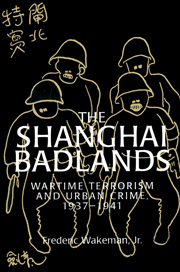Book contents
- Frontmatter
- Contents
- Dedication
- Acknowledgments
- Glossary
- Shanghai, 1940
- Metropolitan Shanghai
- Dedication
- Prologue: Consequences
- 1 Island Shanghai
- 2 Blue Shirts
- 3 National salvation
- 4 Retaliation: Pro-Japanese terrorism
- 5 Provocation: The Chen Lu assassination
- 6 Capitulation: The Xi Shitai assassination
- 7 The puppet police and 76 Jessfield Road
- 8 Terrorism and crime
- 9 Rackets
- 10 Terrorist wars
- 11 Dimout
- Epilogue: Outcomes
- Abbreviations
- Notes
- Bibliography
- Index
11 - Dimout
Published online by Cambridge University Press: 02 November 2009
- Frontmatter
- Contents
- Dedication
- Acknowledgments
- Glossary
- Shanghai, 1940
- Metropolitan Shanghai
- Dedication
- Prologue: Consequences
- 1 Island Shanghai
- 2 Blue Shirts
- 3 National salvation
- 4 Retaliation: Pro-Japanese terrorism
- 5 Provocation: The Chen Lu assassination
- 6 Capitulation: The Xi Shitai assassination
- 7 The puppet police and 76 Jessfield Road
- 8 Terrorism and crime
- 9 Rackets
- 10 Terrorist wars
- 11 Dimout
- Epilogue: Outcomes
- Abbreviations
- Notes
- Bibliography
- Index
Summary
One paradoxically vivid element in all this grayness was the emergence in middle and late 1941 of Dai Li's Blue Shirts. The paradox simply rested in the name itself, which was the term applied by the Shanghainese, the Japanese, and the Westerners to members either of Juntong or of the Loyal and Patriotic National Salvation Army working underground in Shanghai against the puppet and Occupation forces. As we have seen, the Blue Shirts were formally disbanded in 1935 at the behest of the Japanese after the Tangku Agreement was signed with the Nationalist government.
Former members of the Blue Shirts working in security and intelligence under Dai Li were shifted over into the Second Department and eventually became the backbone cadres of the Military Statistics Bureau, or Juntong.
The name “Blue Shirts” stuck with them, however, on the tongues of others, and so the term was used more and more frequently in 1941 to designate the resurgent Nationalist secret service networks operating with increasing impunity in both “island” and occupied Shanghai.
Blue Shirts and day-to-day terrorism
In the fall of 1941, for example, five Shanghai newspapers published a purportedly complete roster of eight executive detachments of the Blue Shirts Society in Shanghai, giving the noms de guerre of squad chiefs and deputy chiefs, as well as of intelligence and communication officers. The extent of the Blue Shirts organization was made plausible in the public's eye by signs of growing guerrilla activity around Shanghai (and especially along the Shanghai-Ningbo railroad) in mid-April before the Japanese initiated their “model peace zone” policy later that July.
- Type
- Chapter
- Information
- The Shanghai BadlandsWartime Terrorism and Urban Crime, 1937–1941, pp. 128 - 135Publisher: Cambridge University PressPrint publication year: 1996



